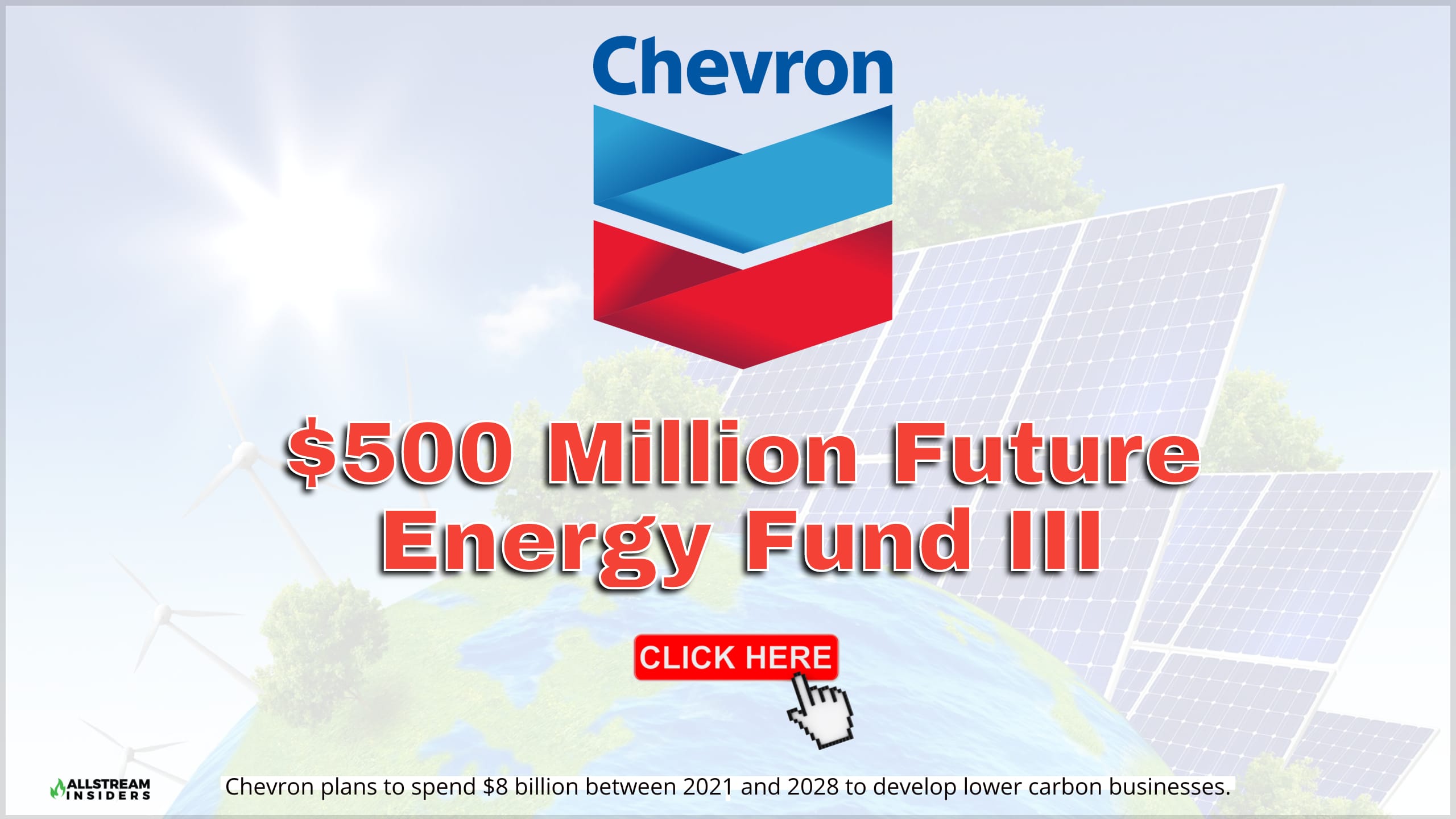These Breaking News are Brought to you By:
Chevron’s Jim Gable recently discussed the company’s Future Energy Fund III at the BloombergNEF Summit.
Jim Gable, president of Chevron Technology Ventures (CTV), recently spoke at a BloombergNEF event in New York. He talked about Chevron’s continued support for innovative energy technologies and businesses.
Three key takeaways:
- CTV has launched its $500 million Future Energy Fund III. This is CTV’s largest fund to date focused on lower carbon technologies.
- This new fund will focus on Series A, B and C companies that are developing innovative energy solutions.
- Chevron plans to spend $8 billion between 2021 and 2028 to develop lower carbon businesses. (This is in addition to a $2 billion investment in carbon reduction projects.)
Transcription of Event:
“Hello, everyone.
Thank you all for joining us here today during your lunch.
It is my pleasure to be here today to talk about accessing and scaling energy innovations, specifically with Jim Gable.
He’s the Vice President of Innovation and President of Chevron Technology Ventures.
The reason we’re here to When we talk about how we scale energy innovation is because we know we need to move faster.
We at BENF are big fans of big numbers.
Last year, there was a total of $1.8 trillion that got invested into global energy transition.
So this is things like scaling renewables, scaling electric vehicle deployment.
And while 1.8 trillion is a record for the amount of investment we have tracked
in a single year, it is still not close to the amount of investment that is needed in order for us to be on track to meet our net zero goals.
According to BNEF modeling, we need to triple that annualized spending to reach $4.8 trillion per year this decade.
And if we want to keep And when we extend that forward out to the 2040s, we need annualized investment into energy transition technologies to hit $7.
6 trillion per year.
So all of this is a way of saying that we need to scale innovation and we need to do it more quickly.
And so today I have with me Jim in order to talk about how corporates can be an essential part of helping us get that scaling, get that technologies to reach scale faster.
So, Jim, how about you start by telling us about…
How about you start by telling us more about Chevron Technology Ventures?
What are your funds? How are you set up?
I’d be glad to. I think the key to today’s session…
I’m really envious of you all eating.
The key to today’s session is Everybody open their potato chips now.
I thought it’ll be that sound of potato chips opening the whole time.
Hey, listen, great to… Look at that. That’s pretty responsive. Well done. I was just kidding.
Eat the potato chips whenever you like.
Great to be here.
Thank you, Stephanie, for the invite. Really excited to be here.
I’ll start with just an overview of CTV and Chevron’s aspirations. I love those capital investment figures. We’ll come back to those.
I think we’re going to spend 20, 25 minutes and maybe take a question or two at the end. I’ll certainly be available at the end to talk if folks want to chat. CTV, we’ve been in business for 25 years.
We’re the primary on-ramp for early-stage innovation to get into Chevron. We say we open doors for the future.
And think about how many technologies a company like Chevron, any large energy company must need to create offshore facilities, run a refinery, work down hole in West Texas.
So many technologies are And of course, in today’s era, where everyone is specialized, and lots of our industrial
horsepower companies in the US have all gone to this open innovation model, where you’re accessing external innovation, how do you transfer that in? And so that’s what CTV is all about.
We have four primary missions.
I can boil them down to two, but four primary missions.
One is, which is fun, we set the technology strategy for Chevron. And so Chevron is undergoing a lot of change.
We certainly We understand that all solutions going forward have to be lower carbon.
The world needs as much affordable, reliable, and ever cleaner energy as it can get its hands on.
And so we set the tech strategy for Chevron in those domains, both core and future technologies, which is great.
Second, third, and fourth missions, which are all part of one goal, is that onboarding and that accessing piece.
We scout for new technologies externally, we access them, and then we transfer them in.
If those have watched the video, We’ve been in business for 25 years.
We’ve learned a lot about how to do that.
I think a lot of it applies to Chevron, a lot of it applies to just industrial America and other industrial companies.
One thing is the transfer piece is the hard part. Maybe I’ll contradict that in a second on another question.
But the transfer piece is a challenge. How do you package something so that the business units in Chevron can adapt
that readily, not have to spend a lot of effort to identify that, de-risk it, trial it, and pilot it, and deploy it.
We have twice as many people working on transferring that technology in as we do externally scouting technologies.
That’s a really important lesson we’ve learned over those 25 years.
On the venture capital side, one of the tools we use to access external technology is venture capital, but by no means is it the only thing we do.
But we do have two venture fund groups.
One is core fund, and you may hear me refer to that, the Core Fund.
We’ve had those funds since 1999. Those are targeting the base business, production operations improvements, digitalization.
Then we have Future Energy Fund. Future Energy funds. We have one started in 2018, one started in 2021.
These are targeting decarbonization of industry, decentralization of energy, circular economy, and mobility.
Obviously, mobility Stephanie is very important to Chevron as well. Today, I’ve got some big news, Stephanie, is that today at this event, we’re announcing we’re launching our third, we’re launching our third
future energy fund, which is going to be $500 million, our biggest fund ever. It’s our 10th fund overall in those two groups over 25 years, but $500
million focused on Series A to Series C. We might get into seed as well, but targeting that $1-$5 million range
of initial investment with, of course, follow-ons through the cycle. That speaks to, $500 million is a lot of money for us. Our previous biggest fund, Future Energy Fund 2, was $300 million. It speaks to Chevron’s commitment to the lower carbon space.
Here we are as a company spending $8 billion by 2028 to develop new carbon business, new, lower carbon businesses, another $2 billion to lower the carbon
intensity of our existing business. Because once again, we know that all solutions are going to be needed, and they all have to be affordable, reliable, and ever cleaner.
Yeah.I mean, a brand new fund. That’s very exciting.It is very exciting.
Now, as you mentioned, you all are celebrating your 25th anniversary of Chevron Technology Ventures.
That means you’ve had enough time to learn some lessons along the way about what are some of the challenges when it comes to scaling technologies.
When it comes to climate tech, specifically, what are some of the challenges that you see out there in the market?
Yeah, I’ll cite two. Look, one, a lot of folks talk about, and I’ll take a different slant on another one.
Everybody knows the capital intensity of making a transition.
Stephanie talked about at the opening, all those capital numbers that she cited.
I’m maybe a little outdated. Maybe the check is getting bigger.
The numbers I always cite are from about 18 months ago.
The International Renewable Energy Agency said it’s going to take 131 trillion
incremental spend by 2050 to get to net zero 2050, if that’s your aspiration.
And whatever we think is feasible, whatever your aspiration is, it speaks to
the size of the overall challenge.
Mckinsey said an incremental three and a half, four trillion.
Stephanie’s numbers are growing even further. And so to that, the capital intensity drives everything in the space.
It drives slow timelines, it drives talent acquisition, it drives displacing current incumbents that have advantages.
It’s a very large, significant issue in this space, and all of us are used to iPhones. I’m used to iPhones.
2007, now they’re on the 15th generation. They come out with a new iteration every year, it seems. Very quick transition.
The climate tech space, whether it’s industry, agriculture, energy, it’s going to take longer than that.
Then the second challenge that clearly is evident, a lot of people talk about it in money terms.
They say, Hey, we need more funds on this valley of death trying to scale some of these technologies.
I’m not sure that’s accurate, and I want to be precise on it because it leads to different solutions.
You need to reduce the risk as opposed to throw money at the challenge.
We’re in a period of low interest rates, and I know they’re going up, but 10 years, 15 years of low interest rates. There’s plenty of money around.
The question is the risk level. We have lots of great folks maybe in this room with infrastructure funds.
They’ll come in if the risk is low. Look at what BlackRock did in West Texas with Oxy’s DAC, Direct Air Capture Unit.
They came in for 500 million because Oxy took a lot of the risk. I’m dating myself a bit, but when I went to grad school in the late ’90s, they taught venture capital. That was the rise of venture capital.
They taught venture capital as, Hey, on the two by two, make sure you take either market risk or technology risk.
If you take both, you’re in the suicide square. Don’t do that. Well, in this space, you have market risk, you have technology risk,
you also have regulatory risk. It’s like a three-dimensional cube, and you’re in the worst part.
It just is heavy risk. Ways to reduce risk are particularly important. I think in the room next door, we’ve got Google, Microsoft, and NewCore talking about aggregating their buying, trying to help backstop
some of the demand uncertainty that some of our renewable developers face.
I think that’s a novel tool and a good effort by them.
Absolutely. I think I want to continue on this concept of risk because one of the things, like you just mentioned, that we’re increasingly seeing is
corporates are finding ways to use their influence to take on the parts of risks that are best suited for them so that other people can take on the parts of risks that match their capital needs.
What about for you all?
What can Chevron Technology Ventures help in terms of addressing those challenges of risk.
Absolutely. I’ll also focus on the earlier stage of things.
One is think about the capabilities, the assets, the customers, the distribution, the supply chain, the systems engineering capabilities
that companies, and maybe it’s larger than just Chevron, it’s industrial companies have to lever into this space.
That’s really, really powerful.
The other thing to think about is on. ..
You I’ll go back to MIT. Folks here may be familiar with MIT Martin Trust Center, and they have a wonderful 24-step process on how to create a successful company,
how to be an entrepreneur.
One of the key steps is go out, talk to customers, It’s find out if the dogs will eat the dog food, as they call it.
That’s the type of early-stage feedback that’s so important for entrepreneurs. Here they are. We know that entrepreneurs, extremely well-intended, they’ll have a technology, they’ll have an idea.
So many times, they have to pivot and move. It’s not the end idea that’s successful that they start with, but they make changes.
So giving companies really early feedback in their development cycle of what the market needs is an area that incumbents can really help with. It doesn’t get talked about enough.
I think of a company we’re invested in, a company called Mainspring Energy, and they have a really novel linear generator, and they’ve redesigned.
You know this because they won one of your awards last year. Yeah, they won a BNEF Pioneer last year. Fantastic.
They have a unique way of changing how chemical energy is translated into electrical energy at about the 125 kilowatt level for one of their cells.
Anyway, we have need for stationary power generation that’s fuel flexible, that’s lower has been in our operations.
We’re piloting with them and trialing a unit out in Colorado right now. Mainspring is learning some really interesting feedback for the first time
in a customer-owned unit instead of a unit that they own, that they’re servicing, about, Hey, how does the customer want to service this themselves?
What’s the maintenance cycle look like?
How do you gain access to the field?
How do you help folks train themselves on what needs to be done? All those tactics.
Because pretty soon, a lot of this deployment becomes tactical at the end of the day, less strategic and tactical when you’re actually out there in the field.
That’s the type of customer feedback that you can get early to the entrepreneur.
Makes sense.
There’s obviously lots of ways in which Chevron as a company, can help these companies grow.
You’re not going to help everyone.
How do you find the opportunities that are the right fit for Chevron technology ventures?
It’s very difficult.
It’s the most difficult thing in the industry, and this is the contradiction to the first thing I said, transferring is the most difficult.
Finding really interesting technologies and entrepreneurs and successful companies is really a challenge.
There are ways we do it related to, I’d say twofold.
One is partnership.
The advantage of being in business in 25 years and investing in over 140 companies is that we have over 350 co-investors that we’ve invested with.
We really operate on the partnership model where a rising tide lifts all boats, and if our partners can succeed, we’ll succeed.
Hopefully, that gets us back into the room the next time they find an opportunity or find a deal, because it is really much a challenge to find the needle in the haystack.
I always say one of the dirty secrets of venture capital is, 90% of the deals out there aren’t worth doing.
There’s too much company formation. Universities have done a great job responding to what their students want. They want to be entrepreneurs.
Back to MIT, they talk about how 40% undergrads, 50% in the business school want to be entrepreneurs and work for themselves.
The universities do a great job responding to that demand and helping people be entrepreneurs and helping people start companies.
But you really got to sort the wheat from the chaff because getting that top decile of opportunities is really tough and partnership helps.
We also work on creativity or creatively trying to address that problem.
We have something that we launched with the National Renewable Energy Lab called Chevron Studio, where we are creating a platform or have created a platform at NREL, where NREL and Chevron link IP sitting on the shelf in universities and national labs
with entrepreneurs looking for their next gig, and we connect those to launch companies.
It’s been very good so far.
We’re on our fourth cohort.
Our largest success to date after two years is a company called Aquanta Vision, which was technology out of Colorado State that takes its electronic filter on existing video feeds.
You don’t need a special camera that can detect methane.
You can use existing camera networks to detect methane leaks.
That’s really valuable, really important.
Once again, it leverages existing infrastructure instead of having to build a whole new infrastructure to get your solution in.
Studio is an example of how we creatively try to find and source deals. Okay. Just to push you further a little bit, you have your four main focus areas,
industrial decarbonization, decentralized energy, circular economy, mobility.
Those are all really active spaces. For startups.
How do you determine which ones are going to be the right fit even within those four for Chevron?
No one said there’d be pushing questions, Stephanie.
For those, we look at… I mean, the simple model is, I think all of us in this business have all sorts scorecards, all sorts of ways to quantify things.
At the end of the day, it’s pattern recognition, and it’s a lot of experience. That’s why experience helps.
What have you seen before? What have you tried before?
It’s amazing.
You ask the folks on the team, and they’ll bring up three other companies out there
doing the same thing or ones they’ve seen before, not in a negative way, but just in a pattern recognition way. But at the highest level, not to get in the quantifying schemes, at the highest level, a lot of people overstate the importance of technology.
Half of it’s management team.
That’s why whatever version we’re going to call this, climate tech, I’ll call it 3.0
You have such better entrepreneurs in the space now that have done some opportunities before, learned a lot, this better management team.
The the other 25% is going to be the business model.
How relevant is the model?
How flexible is it in today’s times?
How are you ensuring that in the value chain, you don’t get backed out and economic rent accrues to somebody else in the chain?
All those questions are really important. Those are the three things that at a high level, we judge our opportunities on.
With 25 years, you have many portfolio companies at this point.
Can you provide me an example of one of your portfolio companies?
How have you helped them grow?
Sure. Let’s start with another one of your winners, I think, Svante.
I know Svante’s CFO is here, so I don’t know if she’s in the room. I won’t take offense if she’s not. We’re an investor in Svante. They’re a point source carbon capture company that uses a metal-organic framework to capture carbon.
Then, of course, you can sell it, you can sequester it, you do whatever you need to do with it.
We first invested in Svante, it was on one of the slides, in 2014, so 10 years ago.
We provided capital, and we continue to provide capital. I’ll get to that in a moment as well. That’s one thing that we do that’s advantageous. We also provided some early market feedback, going back to that earlier point.
We originally invested in them in Texas because we were interested in using the CO₂ for enhanced oil recovery, injecting the ground to go out and get the next barrel of crude.
They were interested in that market, too. We were able to share with them the necessary cost targets, why that’s probably not the market to go after relative to other opportunities.
Very important feedback for them. That’s number two. Number three, we and the DOE funded a pilot at 25 tons per day at one of our oil fields in California that got up and running 15, 18 months ago, start of last year, so 15 months ago.
A sizable unit had cost north of $25 million. Doe funded roughly half of that.
So very useful for them to get an early unit at size applied in the oil field, where they could then think about all the operational issues and tactics, like
I talked that are important for them. Then finally, fourth is the latest funding round for Svante was led by Chevron New
Energies, which is a Chevron division that was started two years ago, two and a half years ago, maybe it’s almost three years now, that is designed to scale lower carbon businesses for Chevron’s future, for society’s future.
They led a round that was more than $300 million, and now they’re helping Svante scale for refineries, other indus trial applications that are of interest to CNE as they build carbon hubs in the US and elsewhere.
That’s a good example of how we started early with venture funding, market insights, led to a pilot as we de-risk.
Once again, the company learned so much from that process, and then you get into a large-scale funding around.
Obviously, now with the new fund, you have new things that you’re going to try to do.
What’s to make this newest fund different from your previous two? Yeah, that’s a good question. We talk a lot about that.
We try to figure out around corners what technologies are going to be of interest.
When we go back to the core areas of Future Energy fund, that group of funds, as I said, mobility, decentralized energy, decarbonization of industry, and circular economy, we’ve learned a lot.
Society has learned a lot.
I want to find and invest in technologies that maybe are outside that suicide square because they leverage existing infrastructure.
You think about lower carbon fuels, think about materials. I don’t know how many folks in New York, probably many in this room, but not everybody, are familiar with what’s going on in California.
Because of the regulation and the government structures put in place, fossil-based diesel is disappearing in California.
Renewable diesel is leveraging the existing infrastructure of diesel delivery to take, I think it’s roughly around half the market right now, with projections for more.
We talk a lot about, Hey, these technologies take so long to come to fruition, so long to get in place.
If they lever existing infrastructure, they don’t necessarily need to.
You see that with EVs as well as you have to build out a charging network.
Leveraging existing infrastructure is really important for us.
There are some materials technologies, there are some fuels technologies that can do that.
Absolutely. Well, we want to make sure that everyone gets a chance to eat.
Also, if you want to come up and ask Jim questions afterwards, please feel free to do so.
But yeah, thank you so much for your time today.
Great to be here. Everyone, round of applause.
Thank you.”
Source: Chevron







